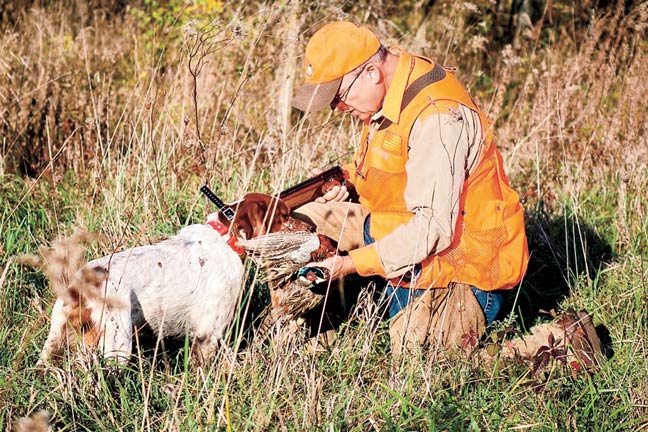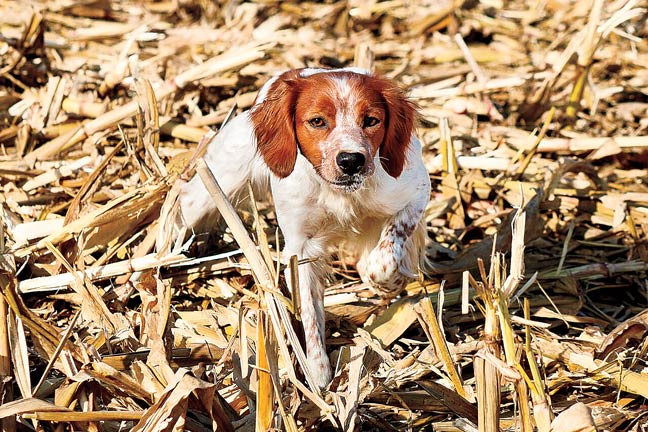The swarm of dogs buzzed and bounced along the edges and deep into the thicket of a dry creekbed until they froze, lined up as if for inspection. That's when I realized there wasn't a mob of canines, just three extremely energetic Epagneul Bretons stilled by the enticing scent filling their nostrils.
One, two, six bobwhites whirred into a cobalt-blue sky, one dropping at Jackie Hutwagner's shot. Fortunately my cameramen captured the shot, marking the first of many stellar performances to be seen later this season on my television show.
Clint LaFary's two-year-old Juno quivered in place until a head tap sent her for the retrieve. She wasted little time delivering it to hand before resuming a frenzied search for more birds. Sweltering early-season temperatures near Bloomfield, Iowa didn't slow an eager, energetic quest that ultimately led to more quail, pheasants, even a woodcock that day.
That was my introduction to Epagneul Bretons — "French Brittany" to most of us; a separate, distinct, unique and very special breed to aficionados. My hunting partners that day, Hutwagner, LaFary, and Todd Farris are among the breed's biggest cheerleaders, owner-trainer-breeders working hard to teach the rest of us the differences between their breed and the dog most of us refer to as "American Brittany."
"They are a prairie dynamo when working and a couch dog when they come inside," Farris said. "Their small size allows them to navigate just about any cover with incredible endurance." After two days in the field with them, I would agree. The compact bundles of vim-and-vigor couldn't wait to get in the field, rolling, jumping and yipping as we shucked shells and donned vests. They epitomized canine joie de vivre.
The origins of both dogs now known as "Brittany" are in, of all things, tourism. Eighteenth-century English hunters ventured to the French province of Bretagne in pursuit of woodcock, bringing their pointers, springers and setters. Those dogs were often left on the continent from season to season (especially after a 1901 English quarantine). The English dogs did what came naturally, interbreeding with smaller local dogs that often had liver or black coats and short tails.
Eventually, French hunters formalized breeding standards, defining what became the Epagneul Breton. Those true believers and their breed have persevered through world wars and economic upheaval, a small-but-dedicated EB community. They are supported by their American counterparts, often literally.
[caption id="attachment_13092" align="aligncenter" width="648"]
French judges officiate at American field trials, groups share similar test and conformation standards, American dogs compete in French trials, and there is plenty of international breeding and importation of pups and adult dogs. Hutwagner, for example, just returned from field trials in Camon and Tincques, France, where his dog Atos stood on the winner's podium several times.
Farris was drawn to that fanatical following on both sides of the Atlantic, but also had a more practical rationale. "I was looking for an easy-to-train dog as a new hunter, and it had to fit the bill as an indoor family dog when not in the field." His daughter, Caitlin, has followed in his paw steps, currently awaiting the birth of her own EB puppy.
In Iowa it was easy to see the genetic origins in the tri-colored dogs racing through timber and cut corn. Black and tan flashed among more familiar brown-and-white packmates. Color variation is much more common in Epagneul Bretons than the American Brittany. But that's not the only difference. French dogs are more compact, smaller, and as the breed standard describes, shorter coupled — body length about equal to height at withers. One French proponent summed it up thusly: "Maximum of qualities in a minimum of volume."
French dogs also have a more pronounced "stop" (bridge of the nose sloping to forehead) and a shorter nose than American Brits. Less leggy, lower to the ground, they are pocket rockets in the field, nimble and dextrous.
Are they the "perfect" gun dog? According to LaFary, perhaps:
"They can sit in the duck blind for a few hours in the morning and hunt upland all afternoon. The same dog can hunt 20 to 30 yards in the ditches at home in Illinois and 150-200 yards in its cast in Montana. All the while sleeping in your bed each night without ripping the house apart."
Hutwagner put it more succinctly: "I wanted a dog for the foot hunter that had a loyal and close relationship with the hunter."
Some describe this smallest of the pointing breeds as "angels in the home and demons in the field." The dogs I hunted with fit the description. On one hunt we weaved our way through thick timber and shin-tangling ground cover, eventually finding Hutwagner's male, Atos, on point backed by Juno.
As I passed the lead dog, a ringneck towered through the grasping branches until he met my shot charge. While I was swinging, a hen rose from the same spot, passed on by Clint. When the second rooster rattled through the dry grass, shots rang and it, too, fell.
In the densest coverts the little Brits excelled. Under, around, through, the Frenchies left no scent unturned. Game on the ground was quickly vacuumed up and delivered; wing-clipped birds were tracked relentlessly with élan'.
"In my opinion Epagneul Bretons seem to be less nervous in nature and a bit more relaxed," Hutwagner suggested.
Being practical, the French (and their American bon frères) have solved an age-old problem vexing pheasant hunters with pointing breeds: running birds. In French trials, "couler'" (koo-LAY) is a command allowing the dog to break point and slowly stalk the scent trail until the bird is once again pointable—or flushable. Birds go up, shots ring out, and dogs get retrieves. Laissez les bons temps rouler! (I'm feeling much better now about how my wirehair handles runners…if I can only brush up on my French pronunciation.)
A weedy peninsula jutted into the corn stubble, hiding a stock-still pointing dog and a pair of bobwhites. A wild flush out the back door was stopped short by my shot. Hutwagner's sharp eye eventually found the dog, but missed the jinking bobwhite. Someone hit it and as dogs searched for the downed bird, Atos screeched to a stop, foot and tail up.
Farris' pup Libby showed a keen interest in the bird, but will have to mature before appreciating the need to honor. Atos remained undeterred, statue-like. A white speck in the distance was LaFary's Juno, backing.
Both mature dogs were steady when the hen took wing, eventually released by their owners to quest for a more colorful bird somewhere in the stubble.
Epagneul Bretons are still finding their way in the American landscape, literally and figuratively. There is a small and dedicated corps of breeder-owners whose goal is to preserve the characteristics of the original breed and distinguish it from the American Brittany. Club de l'Epagneul Breton formed in 1997, with field trials, tests and conformation shows sanctioned by the United Kennel Club. In the field, dogs are evaluated on bird finding abilities, steadiness, retrieving, and water work at various levels.
"I have to hand it to the French. They developed a great upland foot hunter dog and we in the U.S. are committed to the breed and maintaining the French standard. Why change something that works so well?" Farris said.
Elegant like their forefather setters? Hardly. Epagneul Bretons are like the punk progeny of minor royalty—a small chip on their shoulder and out to prove themselves in the field.
Stylish like their pointer predecessors? Nope. Eager and practical in their movement and attitude, these dogs live to hunt and aren't afraid to show it. It's refreshing to see unadulterated doggy emotions, and get caught up in them. Epagneul Bretons want you to hunt with them, right now, right here.
If you get the chance, you should take them up on their offer.
French Britts average around 30-35 pounds, and come in a wider variety of colors and markings than their American cousins. Black, tan, brown (a richer red-brown many refer to as chestnut), liver and white are all in the Epagneul Breton palette. In the U.S., the AKC registers the "American Brittany." The Epagneul Breton was formally recognized by the United Kennel Club, Inc. in 2002.

In the field, the Epagneul Breton moves with a distinct "rolling" gait that is easy, enduring, yet powerful—and which gives the appearance of rolling effortlessly as the dog gallops across the terrain, with head and nose held high, in search of upland game.






